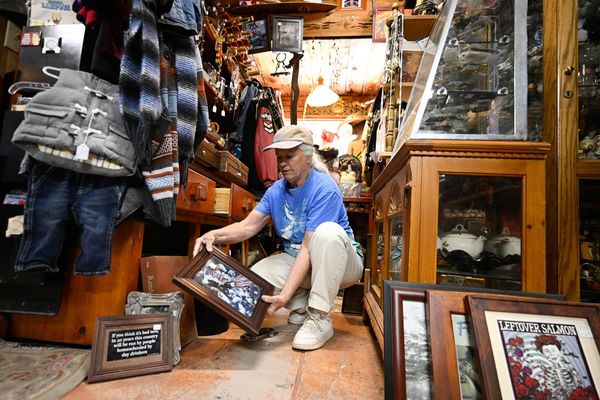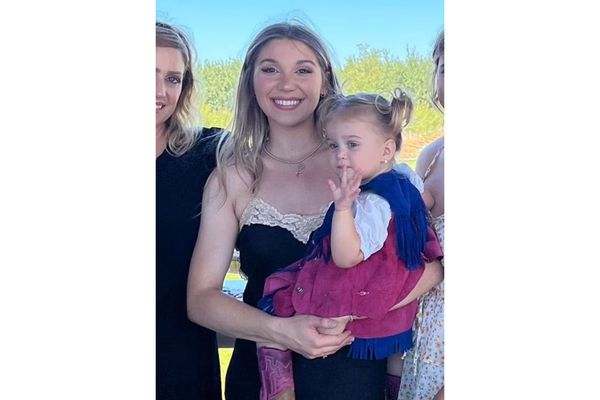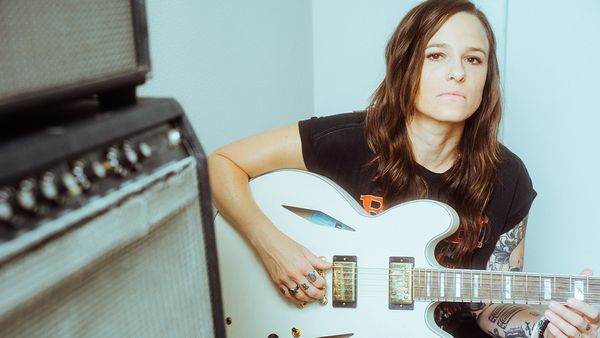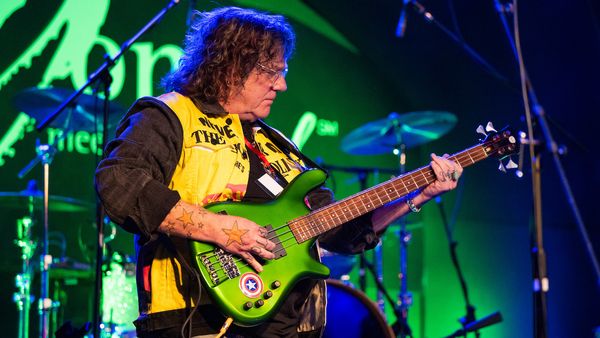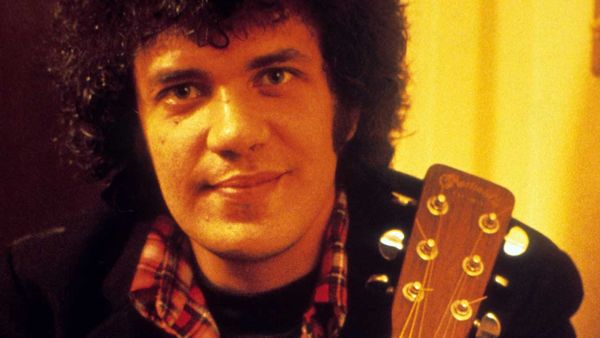
J. Robbins is your cult guitar hero’s guitar hero. Though he began his career in the mid-‘80s as the bassist for D.C. hardcore group Government Issue, he’s perhaps best known as the founding six-stringer of Jawbox. The latter outfit helped push the twitchy, noise-quirked melodicism of post-hardcore into the mainstream with their major label debut, 1994’s For Your Own Special Sweetheart – a record that managed to put them on the road with the Stone Temple Pilots.
After Jawbox imploded in 1997, Robbins kept pace with amp-cranking outfits like Burning Airlines, Channels and Office of Future Plans. He also worked behind the scenes as a producer on tone-saturated emo classics from Texas Is the Reason, Braid, Promise Ring and more. Jawbox themselves have reunited off and on since 2009.
Fast forward to the present, and Basilisk – Robbins’ latest solo album – is full of his usual mountain-leveling, if irregular, guitar hooks. It’s also one of his most dynamic efforts yet, replete with a mix of juddering synth-bass nervousness (Automaticity), distorted electro-drones (Sonder) and cloud-gazing pedal steel ambiance (Not the End).
“It’s true that keyboard textures and abstract sounds are a pretty big part of the record,” Robbins concedes, admitting that even some of its most crunching guitar sections were initially drafted using synth software.
While the album pushes him into new sonic territory, he also wanted to ensure Basilisk felt like a “rock band in a room” record – an urgency he felt was missing from his 2019 solo debut, Un-Becoming.
“That’s an experience that I really missed,” he says of hard-thrumming through live takes of Exquisite Corpse, Desolation Island and others at his Magpie Cage studio in Baltimore, alongside bassist Brooks Harlan and drummer Darren Zentek.
“The energy of that sound still really speaks to me, but I want to go a lot of other places, too. The trick, at the end of it all, was to try and get those two directions to somehow cohere.”
Since Exquisite Corpse really hits that rock-band-in-a-room approach, what do you remember about putting that song together?
“It started in a modified open D tuning that my friend Peter Mansinne showed me, although now I’m half-a-step flat… so actually, it’s in C# [C#G#C#G#G#D# - Ed]. I wasn’t listening to Jimi Hendrix’s I Don’t Live Today, but I had that beat in mind as the impetus.
“I was strumming to that beat in the open tuning, and then the melody came. I don’t want to be just bashing away with my right hand all the time – it needs to have more dimension than that – so I found the alternating picking pattern that’s in the verse.
How did you end up getting Naked Raygun’s John Haggerty to play the solo on the track?
“John is a titan to me, a formative influence. I’m lucky because I’ve known him for a long time. I played bass briefly in his band Pegboy when they did a tour opening for Social Distortion in 1992 – Jawbox were on hiatus because we were transitioning from our first drummer to our second drummer.
“For a lot of what John’s written, the real beauty of it is his directness. First thought, best thought. John has that super power where he could play a B power chord and you just go, ‘Whoa!’ like you’d never heard it before in your life. He’s also a secret shredder.
“I thought, ‘Wouldn’t it be cool if the song had an actual blazing guitar solo?’ It’d be ridiculous if I played it, but I knew someone who could, so I called him up. Jawbox was actually playing at Riot Fest in 2022, so I just made sure to be in Chicago that extra bit of time to get together with John and do that solo. It was really like a dream come true for me.”
Did the solo end up being ‘first thought, best thought?’
“No – but it wasn’t overworked. He was like, ‘What do you want this to sound like?’ I wanted it to sound like John Haggerty. He was thinking more about Eric Clapton but also Michael Schenker.
“I said, ‘Sure! Do your magic!’ He did three or four takes, and it’s probably a comp of the first half of one take and the second half of another.”
There are no doubled rhythm guitars on the rock songs. But there were certain songs where layering was the point
When Basilisk was first announced, you noted that you went into the album not wanting to do a ton of guitar tracking. But there are songs on here like Gasoline Rainbows that have a lot of counterpoint rhythms going on beneath the main riff. How much layering did you do in general?
“There’s not a whole lot. Up until the last solo record I loved the sound of doubled guitars, but it just becomes a fucking slog – I couldn’t hate the process more. I don’t know if it’s because I’m getting older and times a wastin,’ but it’s just the most unrewarding feeling in the world to double rhythm guitars. It goes right against the feeling of immediacy I wanted to have for this record.
“Also, I’m a huge Killing Joke fan. I read somewhere that Geordie Walker also had an abhorrence of doubling rhythm guitars, and that his solution to that was to use an automatic double tracker.
“Like, he would run the guitar in stereo and split the signal not just with an AB box, but with an ADT. He would have also inserted some kind of modulated echo that he could mix into the signal as a kind of seasoning.
“So it’s a left side with a right side that’s subtly changing pitch and timing the whole time. I just bit that move, basically! There are no doubled rhythm guitars on the rock songs. But there were certain songs where layering was the point.”
It feels like pitch-bending is a huge part of this record – Automaticity features some stereophonic, ping-ponging whammy sections, for instance. There was a Jawbox live session on KEXP a few years back, too, where you threw a lot of whammy into older songs like 68, though you’d played it straight in the ‘90s. How have you gone about developing your approach to the bar over the years?
“I think the interest in pitch-bending comes from listening to a certain amount of shoegaze music – Swervedriver particularly, and My Bloody Valentine – but somewhere in there it was also the desire to not have to worry so much about whether I’m fretting accurately, because the pitch is always moving.
I threw the guitar across the room in a childish fit… that was a moment of real change for me. I was like, ‘This is a thing I will never do again, and a way I will never be again’
“When Jawbox were together I was changing guitars all the time. I had Teles, Tele Deluxes, SGs, Melody Makers… pawn shop guitars, for the most part. At one point I had this ‘70s Jazzmaster. Someone had swapped out the pickups for DiMarzio Super Distortions in the bridge.
“They had refinished it with white primer, so they totally destroyed the resale value of this guitar, but it was the greatest fucking guitar. And it had a whammy bar.”
“The sad end of that ‘70s Jazzmaster is that there was a Jawbox show that was going very badly for me, and I threw it across the room in a childish fit. It snapped the headstock. I had it repaired, but it was never the same.
“I ended up giving it to a friend, actually. That was a moment of real change for me. I was like, ‘This is a thing I will never do again, and a way I will never be again, because I just lost my dearest companion.’”
You seem to have stuck with offsets since then. Where did you come across the Schecters you’re playing these days?
“This was right around the time we toured with the Stone Temple Pilots, and the DeLeo brothers both had an association with Schecter – Robert actually worked in the custom shop.
“The DeLeo brothers were extremely supportive and sweet to us. They hung out; they helped us move gear sometimes. [Former Jawbox guitarist] Bill Barbot was playing a Schecter PT Tele, too, so we kind of bonded with them over that.
“Robert helped us get an endorsement deal. The black Spitfire that I play, which is in drop C# standard, was a prototype from the custom shop. I also have a Hellcat that my friend Dan Kozak gave me. That’s the guitar that I play most often now.
“It came with mini-humbuckers, which I’m not a great fan of, so we put a [Seymour Duncan JB] Jeff Beck pickup in the bridge. Both guitars have the Beck pickups, but the Hellcat is a little beefier-sounding.”
Brooks Harlan has been in your orbit for a long time now. He previously played bass in your Office of Future Plans project; he joined Jawbox on guitar after Bill left in 2021; and he’s playing bass on both of your solo records. What’s the relationship like there?
“Brooks is one of my greatest friends in the world. He’s an inspiring guy – smart, chill, capable.
It made me sad when I realized Gordon Withers is only on two of the songs… but what he does on those songs is just phenomenal
“When we tracked the guitars for the rock band tunes on this record, the setup on one side of the stereo image was my JCM800, a 1989 50-watt MK II with an Avatar 2x12 that has bottom-of-the-line Celestions in it. The other side is a Hiwatt clone that Brooks actually built – among his many talents, he designs and repairs tube amps.
“At one point I’d borrowed this killer ‘70s Hiwatt DR502 from my friend Andy Bopp, who is an amazing songwriter in Baltimore that I’ve worked with. I’ve always been obsessed with Hiwatts, going back to John Haggerty and Jesus Lizard’s Duane Denison, and I’d asked Brooks if he could build me a clone.
“It was cool because he had an old Traynor chassis with the power transformer still intact, so he was able to build it for me fairly cheaply. He built a copy of a DR502 from a schematic he found online, but it didn’t sound quite right to me.
“Then Andy loaned us his head, and basically that amp schematic was just a few months off from the one Andy owned, which had more gain than the earlier ‘70s circuit.
“Then we have Yellowjackets on the power tubes, so it runs EL84s in place of EL34s. You can crank the volume up and saturate the power tubes. That’s the John Haggerty thing – he just cranks the fuck out of the Hiwatt head and also uses very high output pickups.
“I wanted to make sure to give props to Brooks and his amp company, Big Crunch, because he also built the bass head that’s on the record.
“I should also say that [guitarist/cellist] Gordon Withers played on just about every song on my first solo record. He’s in my touring band, and is a cherished collaborator of mine, but Gordon’s not on Basilisk all that much.
“I think part of the reason was a desire to strip things down. It made me sad when I realized he’s only on two of the songs, you know? But what he does on those songs is just phenomenal. He added these beautiful harmonics and countermelodies to Old Soul. To me, those are now the main melodies of the song.”
- Basilisk is available now in digital and vinyl formats.



